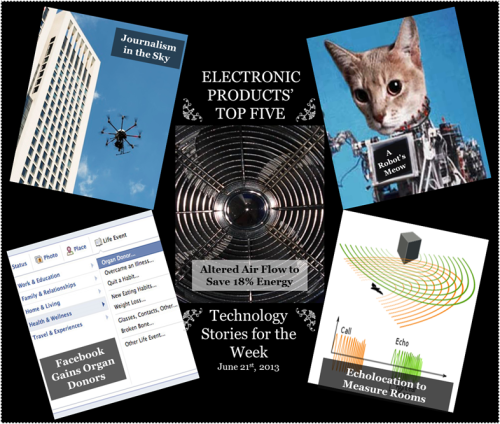
It has been a pretty interesting week for technology. Facebook began a new program where users can indicate if they are an organ donor, drones acting as news cameras are facing an ethical debate, and a new invention would save building owners thousands of dollars.
Read on for more!
Echolocation to Measure Rooms
A team of researchers are finding a way to pick up the contours of a room and create a 3D map. This method would work with a series of microphones, placed anywhere, that pick up the direct sound that echoes back from each wall. The software will compare each echo, the distance the microphone is from the wall, and how long the echo took to come back. The team has tested the new software in an empty room with a moveable wall and their results were valid. When they tested it in a Cathedral the results weren’t as accurate. Researchers are working on improving the system suggesting that one day architects could use this method as well as forensic scientists figuring out things like where someone is making a call from.
Altered Air Flow to Save 18% Energy
Scientist are revealing that with a new customizing fan, building owners will be able to save thousands of dollars taking energy bills down 18%. This method measures the amount of people who walk into a room and cools or heats the room accordingly. The team at the Building Controls Laboratory says there’s no reason to have a fan circulating air in a room that seats 200 when no one is in there, but the minute people start to enter the system goes on. This is why a big room with little people often feels too cold.
Journalism in the Sky
Some say journalism is a dying industry, but “drone journalism” could change that. Originally used for manhunts in Pakistan, drones are making their way to the forefront of the news circuit. Drones are useful for taking pictures and videos in areas that reporters normally wouldn’t be allowed to enter, like a person’s private property. This method has been looked at from an ethical and legal angle and the team at the University of Texas – Arlington is unsure what will happen after the Federal Aviation Administration releases a statement. In the past when these images were captured, they were typically of top-secret government activities that were not allowed to air on the news, but they had no problem finding their way to YouTube.
A Robot’s Meow
It would be rare to see an everyday house cat looking around a rescue mission site, unless it’s a robotic cat. A team at EPFL’s Biorobotics Lab has created a “cheetah-cub robot” that is faster and more stable than other robots. The legs of the robot are built to be agile like a cat and maneuver itself over rough terrain using small steps. It can run seven times its body length in one second, which will come in handy in the future. The team is hoping that once the cheetah-cub gets past its beginning stages it will be used for exploration and rescues missions after natural disasters.
Facebook Gains Organ Donors
In the United States, there are over 100,000 patients waiting for an organ donation of some kind. The number of organ donors does not match those in need, so Dr. Cameron of John Hopkins University decided to take the issue to Facebook and create a program where if one person updated their profile to “organ donor” then their friends would see that and have an option to update their profile too. Cameron reports that the registration gained 13,054 new organ donors. With this initiative there were large spikes, especially in Michigan and Georgia, continuing through the next 12 days.
Advertisement
Learn more about Electronic Products Magazine





